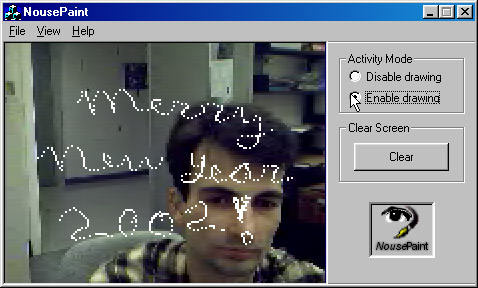Read in Principles for Designing Computer Music Controllers, the Nukulele is a nice modified ukulele!
The Nukelele (thanks to Michael Brooke for the name) was constructed in Bob Adams’ Interval Research Expressions project. While collaborating on other Expressions projects such as “the Stick” and the “ Porkophone,” the Nukelele was a personal experiment to design, implement, and test a new controller as rapidly as possible. The Nukelele was intended to match the expressiveness of a true stringed instrument, by using audio directly from a sensor to drive a plucked string physical model. Two sandwiched linear force sensing resistors under the right hand served to provide pluck/strike position information, along with the audio excitation for the string model.


 Some songs .(mp3):
Some songs .(mp3):  The fact that the button are so huge is interesting, people really have something to manipulate here.
The fact that the button are so huge is interesting, people really have something to manipulate here. The interface is pretty rough on the website screenshots, here is an example of how the radar displays the haunted areas:
The interface is pretty rough on the website screenshots, here is an example of how the radar displays the haunted areas:

 There seems to be a collaborative cartography project as well: the website depicts
There seems to be a collaborative cartography project as well: the website depicts  Now let's think about this kind of interface could be hacked, tricked or modified: this wired driller could be a powerful controller for weird gaming purposes.
Now let's think about this kind of interface could be hacked, tricked or modified: this wired driller could be a powerful controller for weird gaming purposes.
 A video (avi)
A video (avi) 




 I find this interesting since mobile tech (as a subset of technology in general) is sometimes frightening for lots of users, here they offer a funny way to get back to the past. I would like to know more about current use of those old-school handset!!!
I find this interesting since mobile tech (as a subset of technology in general) is sometimes frightening for lots of users, here they offer a funny way to get back to the past. I would like to know more about current use of those old-school handset!!! This is how it works:
This is how it works:
 This is an amazing example of how tangible interaction techniques coudl support innovative joint activities. Applied to other context (i.e. ... video games) this would be nice.
This is an amazing example of how tangible interaction techniques coudl support innovative joint activities. Applied to other context (i.e. ... video games) this would be nice. It's designed by the same team who did the cool
It's designed by the same team who did the cool 
 This kind of stuff is now closer to the market. Phone companies are up to releasing similar projects. I am eager to see people waving in the streets just to zip files or to shuffle songs in their ipods!
This kind of stuff is now closer to the market. Phone companies are up to releasing similar projects. I am eager to see people waving in the streets just to zip files or to shuffle songs in their ipods! Definitely a tangible-oriented design!
The corresponding scientific paper: Baillie, S., Crossan, A., Brewster, S.A., Mellor, D. and Reid, S.
Definitely a tangible-oriented design!
The corresponding scientific paper: Baillie, S., Crossan, A., Brewster, S.A., Mellor, D. and Reid, S.